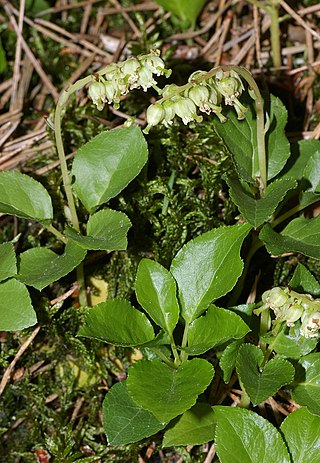
The International Union for Conservation of Nature (IUCN) Red List of Threatened Species, also known as the IUCN Red List or Red Data Book, founded in 1964, is an inventory of the global conservation status and extinction risk of biological species. A series of Regional Red Lists are produced by countries and organizations, which assess the risk of extinction to species within a political management unit.

Scutellaria montana, with the common names largeflower skullcap, large-flowered skullcap and mountain skullcap, is an perennial forb first described by Alvan Chapman in 1878. This narrowly endemic species is found in the southeastern United States in parts of the Ridge and Valley and Cumberland Plateau Physiographic Provinces. Populations have been documented from four Tennessee counties and nine Georgia counties and is protected under the US Endangered Species act as it is a threatened species. The Latin specific epithet montana refers to mountains or coming from mountains.

Desmodium is a genus of plants in the legume family Fabaceae, sometimes called tick-trefoil, tick clover, hitch hikers or beggar lice. There are dozens of species and the delimitation of the genus has shifted much over time.

Asclepias purpurascens, the purple milkweed, is a herbaceous plant species. It is in the genus Asclepias, making it a type of milkweed. It is native to the Eastern, Southern and Midwestern United States similar to the range of the common milkweed. The plant gets its name from the flowers that first develop a pink color but then turn darker purple as they mature. Unlike common milkweed, purple milkweed prefers some shade and is considered a plant of partial shade. It is also considered an indicator of oak savanna, especially in Wisconsin. The species rarely produces seed pods which are smooth instead of the rough warty ones produced by common milkweed.

Senna hebecarpa, with the common names American senna and wild senna, is a species of legume native to eastern North America.

Viburnum nudum is a deciduous shrub in the genus Viburnum within the muskroot family, Adoxaceae.

Orthilia is a genus of flowering plants in the family Ericaceae. It has only one species, Orthilia secunda. Its common names are sidebells wintergreen, one-sided-wintergreen and serrated-wintergreen. It is also called one-sided pyrola, one-sided shinleaf, and one-sided wintergreen. It was previously part of genus Pyrola, the wintergreens.

Asclepias viridiflora, is commonly known as green comet milkweed, green-flower milkweed, and green milkweed. It is a widely distributed species of milkweed (Asclepias), known from much of the eastern and central United States from Connecticut to Georgia to Arizona to Montana, as well as southern Canada. The Latin specific epithet viridiflora means green-flowered.

Desmodium illinoense, the Illinois ticktrefoil, is a flowering plant in the bean family (Fabaceae), native to the central United States and Ontario, Canada. Illinois ticktrefoil grows in sunny places, such as prairies and oak savannas of the Great Plains and Great Lakes regions.

Atriplex glabriuscula, common names Scotland orache, smooth orache, Babington's orache or seaside orach is an Atriplex species native to North America and northern Europe. It is an annual.

Salix pedicellaris, the bog willow, is a species of willow. It grows as a shrub.

Salix petiolaris, common name slender willow or meadow willow, is a species of willow.

Desmodium sessilifolium, common name sessileleaf ticktrefoil, is a species of plant in the legume family, Fabaceae. It is native to North America.

Calystegia spithamaea, which common names include: low false bindweed, low bindweed, erect bindweed, and upright bindweed, is a species of plant found in eastern North America.

Carex alopecoidea, common names foxtail sedge and northern fox sedge, is a species of Carex native to North America. It is listed as threatened in Connecticut. It is listed as endangered in Indiana, New Jersey, Ohio, as possibly extirpated in Maine, as threatened in Massachusetts, and as endangered and possibly extirpated in Tennessee.

Carex collinsii, common name Collins' sedge, is a species of Carex native to North America. It is listed as a special concern species and believed extirpated in Connecticut. It is listed as endangered in New York, as threatened in Pennsylvania, and its historical range included Rhode Island.

Carex crawfordii, common name Crawford sedge, is a species of Carex native to North America.

Juncus debilis, the weak rush, is a plant indigenous to the United States. It is listed as endangered in Massachusetts and New York, and as threatened in Rhode Island. It is listed as a species of special concern in Connecticut and believed extirpated in that state.
Crocanthemum dumosum, common names bushy frostweed and bushy rockrose, is a perennial plant that is native to the United States.

Pityopsis falcata, common names sickleleaf silkgrass and sickle-leaved golden aster, is perennial species of flowering plant in the family Asteraceae that is native to the United States and has been introduced to Canada.




















